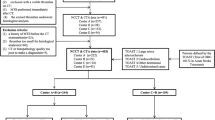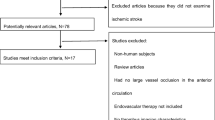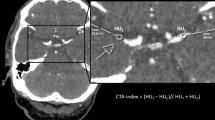Abstract
Purpose
To establish a nomogram incorporating pretreatment imaging parameters and clinical characteristics for predicting the thrombus composition of acute ischemic stroke (AIS) with large vessel occlusion (LVO).
Methods
We retrospectively enrolled patients with occlusion of the Middle Cerebral Artery (MCA) who underwent Mechanical Thrombectomy (MT). Retrieved thrombi were stained with Hematoxylin and Eosin (H&E) and Martius Scarlet Blue (MSB). Thrombi are assigned to the Fibrin-rich or RBC-rich group based on the relative fractions of Red Blood Cells (RBC), fibrin, and platelet. The independent risk factors for Fibrin-rich clots were determined via univariate and multivariate logistic regression analysis and were then integrated to establish a nomogram.
Results
In total, 98 patients were included in this study. Patients with fibrin-rich clots had worse functional outcome [modified Rankin scale (mRS) 0–2, 34.7% vs 63.2%, p = 0.005], longer procedure time (76.8 min vs 50.8 min, p = 0.001), and increased maneuvers of MT (1.84 vs 1.46, p = 0.703) than those with RBC-rich clots. The independent risk factors for Fibrin-rich clots were lower perviousness measured by Non-Contrast Computer Tomography (NCCT) and CT Angiography (CTA), lower thrombus relative attenuation on NCCT, elevated Platelet-WBC ratio (PWR) of admission peripheral blood, and previous antithrombotic medication. The nomogram showed good discrimination with an area under the Receiver Operating Characteristic (ROC) curve (AUC) of 0.852 (95% CI: 0.778–0.926). The calibration curve and decision curve analysis also displayed satisfactory accuracy and clinical utility.
Conclusion
This study has developed and internally validated an easy-to-use nomogram which can help predict clot composition and optimize therapeutic strategies for thrombectomy.



Similar content being viewed by others
Data availability
All data relevant to the study are included in the article.
References
Mendelson SJ, Prabhakaran S (2021) Diagnosis and management of transient ischemic attack and acute ischemic stroke: a review. JAMA 325:1088–1098
Goyal M, Menon BK, van Zwam WH, Dippel DW, Mitchell PJ, Demchuk AM et al (2016) Endovascular thrombectomy after large-vessel ischaemic stroke: a meta-analysis of individual patient data from five randomised trials. Lancet (London, England) 387:1723–1731
Jolugbo P, Ariëns RAS (2021) Thrombus composition and efficacy of thrombolysis and thrombectomy in acute ischemic stroke. Stroke 52:1131–1142
Liebeskind DS, Sanossian N, Yong WH, Starkman S, Tsang MP, Moya AL et al (2011) CT and MRI early vessel signs reflect clot composition in acute stroke. Stroke 42:1237–1243
Patel TR, Fricano S, Waqas M, Tso M, Dmytriw AA, Mokin M et al (2021) Increased perviousness on CT for acute ischemic stroke is associated with fibrin/platelet-rich clots. AJNR Am J Neuroradiol 42:57–64
Berndt M, Friedrich B, Maegerlein C, Moench S, Hedderich D, Lehm M et al (2018) Thrombus permeability in admission computed tomographic imaging indicates stroke pathogenesis based on thrombus histology. Stroke 49:2674–2682
Fitzgerald S, Wang S, Dai D, Murphree DH Jr, Pandit A, Douglas A et al (2019) Orbit image analysis machine learning software can be used for the histological quantification of acute ischemic stroke blood clots. PLoS One 14:e0225841
Boodt N, Compagne KCJ, Dutra BG, Samuels N, Tolhuisen ML, Alves H et al (2020) Stroke etiology and thrombus computed tomography characteristics in patients with acute ischemic stroke: a MR clean registry substudy. Stroke 51:1727–1735
Songsaeng D, Kaeowirun T, Sakarunchai I, Cheunsuchon P, Weankhanan J, Suwanbundit A et al (2019) Efficacy of thrombus density on noninvasive computed tomography neuroimaging for predicting thrombus pathology and patient outcome after mechanical thrombectomy in acute ischemic stroke. Asian J Neurosurg 14:795–800
Benson JC, Fitzgerald ST, Kadirvel R, Johnson C, Dai D, Karen D et al (2020) Clot permeability and histopathology: is a clot’s perviousness on CT imaging correlated with its histologic composition? J Neurointerventional Surg 12:38–42
Ye G, Cao R, Lu J, Qi P, Hu S, Chen K et al (2021) Histological composition behind CT-based thrombus density and perviousness in acute ischemic stroke. Clin Neurol Neurosurg 207:106804
Benson JC, Kallmes DF, Larson AS, Brinjikji W (2021) Radiology-pathology correlations of intracranial clots: current theories, clinical applications, and future directions. AJNR Am J Neuroradiol 42:1558–1565
Brinjikji W, Duffy S, Burrows A, Hacke W, Liebeskind D, Majoie C et al (2017) Correlation of imaging and histopathology of thrombi in acute ischemic stroke with etiology and outcome: a systematic review. J Neurointerventional Surg 9:529–534
Mohammaden MH, Haussen DC, Perry da Camara C, Pisani L, Olive Gadea M, Al-Bayati AR et al (2021) Hyperdense vessel sign as a potential guide for the choice of stent retriever versus contact aspiration as first-line thrombectomy strategy. J Neurointerventional Surg 13:599–604
Bruggeman AAE, Aberson N, Kappelhof M, Dutra BG, Hoving JW, Brouwer J et al (2022) Association of thrombus density and endovascular treatment outcomes in patients with acute ischemic stroke due to M1 occlusions. Neuroradiology
Dutra BG, Tolhuisen ML, Alves H, Treurniet KM, Kappelhof M, Yoo AJ et al (2019) Thrombus imaging characteristics and outcomes in acute ischemic stroke patients undergoing endovascular treatment. Stroke 50:2057–2064
Qiu W, Kuang H, Nair J, Assis Z, Najm M, McDougall C et al (2019) Radiomics-based intracranial thrombus features on CT and CTA predict recanalization with intravenous alteplase in patients with acute ischemic stroke. AJNR Am J Neuroradiol 40:39–44
Hofmeister J, Bernava G, Rosi A, Vargas MI, Carrera E, Montet X et al (2020) Clot-based radiomics predict a mechanical thrombectomy strategy for successful recanalization in acute ischemic stroke. Stroke 51:2488–2494
Sarioglu O, Sarioglu FC, Capar AE, Sokmez DF, Mete BD, Belet U (2021) Clot-based radiomics features predict first pass effect in acute ischemic stroke. Interv Neuroradiol: J Peritherapeutic Neuroradiol Surg Proced Relat Neurosci 15910199211019176
Hanning U, Sporns PB, Psychogios MN, Jeibmann A, Minnerup J, Gelderblom M et al (2021) Imaging-based prediction of histological clot composition from admission ct imaging. J Neurointerventional Surg 13:1053–1057
Essig F, Kollikowski AM, Pham M, Solymosi L, Stoll G, Haeusler KG, et al (2020) Immunohistological analysis of neutrophils and neutrophil extracellular traps in human thrombemboli causing acute ischemic stroke. Int J Mol Sci 21
Pilato F, Valente I, Calandrelli R, Alexandre A, Arena V, Dell’Aquila M et al (2022) Clot evaluation and distal embolization risk during mechanical thrombectomy in anterior circulation stroke. J Neurol Sci 432:120087
Chen Z, Huang Y, Li S, Lin J, Liu W, Ding Z et al (2016) Platelet-to-white blood cell ratio: a prognostic predictor for 90-day outcomes in ischemic stroke patients with intravenous thrombolysis. J Stroke Cerebrovasc Dis: off J Natl Stroke Assoc 25:2430–2438
Wang L, Cheng Q, Peng M, Lv D, Zi W, Xu G et al (2020) The relationship between the platelet to leukocyte ratio and mechanical thrombectomy outcomes in acute ischemic stroke patients. Neurol Res 42:890–896
Sarioglu O, Capar AE, Bas Sokmez DF, Topkaya P, Belet U (2021) Relationship between the first pass effect and the platelet-lymphocyte ratio in acute ischemic stroke. Interv Neuroradiol: J Peritherapeutic Neuroradiol Surg Proced Relat Neurosci 27:523–530
Berndt M, Mück F, Maegerlein C, Wunderlich S, Zimmer C, Wirth S et al (2021) Introduction of CTA-index as simplified measuring method for thrombus perviousness. Clin Neuroradiol 31:773–781
Funding
Project supported by National Natural Science Foundation of China (81971613); Interventional Medicine Research Fund of Jiangsu Medical Association (SYH-3201140–0024).
Author information
Authors and Affiliations
Contributions
WCD and JZY conceived and designed the research. HY, CYZ, and ZLB acquired the data. JJC, LMF, XXQ, LSS, JL, LQH, and SHB analyzed and interpreted the data. WCD and HY drafted the manuscript. LS and JZY made critical revisions to the manuscript. All authors approved the final manuscript.
Corresponding authors
Ethics declarations
Conflict of interest
The authors declare no competing interests.
Ethical approval
IRB approval was obtained through The First Affiliated Hospital with Nanjing Medical University.
Consent for publication
Not required.
Additional information
Publisher's note
Springer Nature remains neutral with regard to jurisdictional claims in published maps and institutional affiliations.
Rights and permissions
Springer Nature or its licensor holds exclusive rights to this article under a publishing agreement with the author(s) or other rightsholder(s); author self-archiving of the accepted manuscript version of this article is solely governed by the terms of such publishing agreement and applicable law.
About this article
Cite this article
Wang, C., Hang, Y., Cao, Y. et al. A nomogram for predicting thrombus composition in stroke patients with large vessel occlusion: combination of thrombus density and perviousness with clinical features. Neuroradiology 65, 371–380 (2023). https://doi.org/10.1007/s00234-022-03046-0
Received:
Accepted:
Published:
Issue Date:
DOI: https://doi.org/10.1007/s00234-022-03046-0




